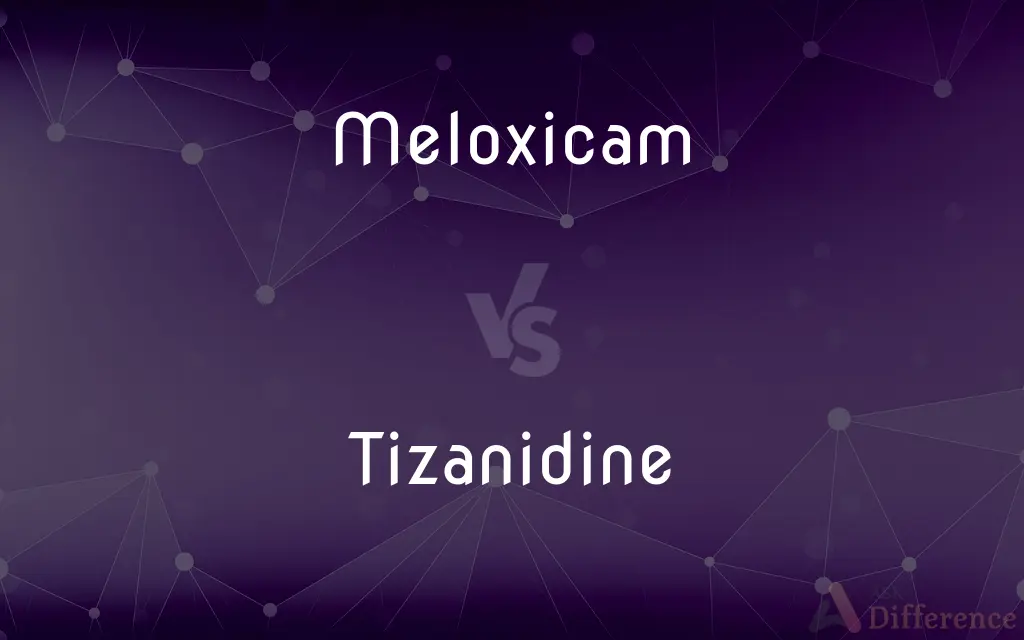Meloxicam vs. Tizanidine — What's the Difference?
By Tayyaba Rehman & Urooj Arif — Updated on March 8, 2024
Meloxicam is a nonsteroidal anti-inflammatory drug (NSAID) used to relieve pain and inflammation in arthritis. Tizanidine is a muscle relaxant that treats muscle spasms caused by conditions like multiple sclerosis or spinal injury.

Difference Between Meloxicam and Tizanidine
Table of Contents
ADVERTISEMENT
Key Differences
Meloxicam operates by inhibiting enzymes (COX-1 and COX-2) that contribute to inflammation and pain in the body, making it effective for long-term management of arthritis symptoms such as swelling, stiffness, and joint pain. Tizanidine, on the other hand, works in the central nervous system to relax muscles by blocking nerve impulses (or pain sensations) that are sent to the brain, which is why it is prescribed for temporary relief of muscle spasms.
While both drugs are used to manage pain, their applications differ significantly. Meloxicam is used for chronic conditions associated with arthritis and other inflammatory joint disorders, providing relief from the symptoms of these conditions. Tizanidine is more suitable for acute conditions that cause muscle spasms, offering temporary relief as part of a broader treatment plan that may include physical therapy.
Meloxicam's side effects might include gastrointestinal issues such as ulcers or bleeding, cardiovascular problems, and kidney issues, reflecting its systemic effect on inflammation and pain pathways. Tizanidine can cause side effects such as drowsiness, dry mouth, and low blood pressure, which are related to its muscle relaxant properties and central nervous system effects.
Both meloxicam and tizanidine require careful prescription oversight to avoid interactions with other medications and to manage risks, especially for long-term use. Meloxicam may interact with other NSAIDs, anticoagulants, and specific blood pressure medications, while tizanidine's interactions include alcohol, benzodiazepines, and certain antidepressants, highlighting the importance of monitoring by healthcare professionals.
The choice between meloxicam and tizanidine depends on the specific medical condition being treated. Meloxicam is more appropriate for long-term management of inflammatory conditions, whereas tizanidine is preferred for short-term relief of muscle spasms. Both medications require consideration of the patient's overall health profile and potential drug interactions.
ADVERTISEMENT
Comparison Chart
Classification
Nonsteroidal anti-inflammatory drug (NSAID)
Muscle relaxant
Mechanism
Inhibits COX enzymes, reducing inflammation and pain
Blocks nerve impulses in the brain to relax muscles
Use
Long-term management of arthritis and other inflammatory disorders
Short-term relief of muscle spasms
Side Effects
Gastrointestinal issues, cardiovascular risk, kidney issues
Drowsiness, dry mouth, low blood pressure
Interactions
Other NSAIDs, anticoagulants, blood pressure medications
Alcohol, benzodiazepines, antidepressants
Compare with Definitions
Meloxicam
A medication for reducing inflammation and pain in arthritis.
The doctor prescribed meloxicam to manage her arthritis symptoms.
Tizanidine
Can cause drowsiness and low blood pressure.
Tizanidine made her feel sleepy, so she had to adjust her dosage.
Meloxicam
Suitable for chronic inflammatory conditions.
Long-term use of meloxicam can help maintain mobility in arthritis patients.
Tizanidine
Interaction risk with alcohol and certain other drugs.
The doctor warned against using alcohol while taking tizanidine for safety reasons.
Meloxicam
Works by inhibiting enzymes that cause inflammation.
Meloxicam's effectiveness comes from its ability to reduce swelling and joint pain.
Tizanidine
Acts on the central nervous system to relax muscles.
The muscle relaxation from tizanidine helped improve his physical therapy sessions.
Meloxicam
May cause gastrointestinal and cardiovascular side effects.
He experienced stomach issues after starting meloxicam.
Tizanidine
A muscle relaxant for treating spasms.
Tizanidine was prescribed to relieve her muscle spasms after a spinal injury.
Meloxicam
Requires monitoring for interactions with other medications.
The pharmacist checked for interactions before dispensing meloxicam.
Tizanidine
Used for temporary relief of muscle-related discomfort.
She took tizanidine to manage spasms during her MS flare-ups.
Meloxicam
Meloxicam, sold under the brand name Mobic among others, is a nonsteroidal anti-inflammatory drug (NSAID) used to treat pain and inflammation in rheumatic diseases and osteoarthritis. It is used by mouth or by injection into a vein.
Tizanidine
Tizanidine, sold under the brand name Zanaflex among others, is a medication that is used to treat muscle spasticity due to spinal cord injury or multiple sclerosis. Effectiveness appears similar to baclofen or diazepam.
Meloxicam
A nonsteroidal anti-inflammatory drug, C14H13N3O4S, used to treat osteoarthritis and rheumatoid arthritis.
Tizanidine
A particular drug used as a muscle relaxant.
Meloxicam
(pharmaceutical drug) A non-steroidal anti-inflammatory drug of the oxicam class (trademark Mobic), used to relieve the symptoms of arthritis and primary dysmenorrhea and as an analgesic.
Common Curiosities
Is Tizanidine safe for long-term use?
Tizanidine is usually prescribed for short-term relief due to potential side effects and dependency risks.
Are there any dietary restrictions with Meloxicam?
While specific dietary restrictions aren't common, it's important to avoid alcohol to reduce the risk of stomach ulcers.
Can I drink alcohol with Tizanidine?
Alcohol can increase the nervous system side effects of Tizanidine, such as dizziness and drowsiness.
What is Meloxicam used for?
It's used for relieving pain and inflammation in arthritis and similar inflammatory conditions.
Can Meloxicam be used for muscle spasms?
Meloxicam is not typically used for muscle spasms; it's for inflammation and pain in conditions like arthritis.
How does Tizanidine work?
Tizanidine works by blocking nerve impulses in the brain to reduce muscle spasms.
Can I use Meloxicam for acute pain?
Yes, Meloxicam can be used for acute pain related to inflammation, but it's often prescribed for chronic conditions.
What should I avoid while taking Meloxicam?
Avoid using other NSAIDs and be cautious with anticoagulants and certain blood pressure meds.
Can Tizanidine affect blood pressure?
Yes, it can cause low blood pressure and dizziness, especially when standing up quickly.
How quickly does Tizanidine work?
Tizanidine typically begins to work within 1-2 hours after taking it, providing temporary relief from muscle spasms.
What's the difference in side effects between Meloxicam and Tizanidine?
Meloxicam may cause gastrointestinal and cardiovascular issues, while Tizanidine can lead to drowsiness and dry mouth.
Is it safe to take Meloxicam with blood pressure medication?
It requires careful monitoring as Meloxicam can affect kidney function, impacting blood pressure control.
What are the risks of long-term Meloxicam use?
Long-term use can increase the risk of gastrointestinal bleeding, heart attack, and stroke.
Does Tizanidine help with chronic muscle pain?
It can be used as part of a treatment plan for chronic conditions, but its primary use is for temporary relief of muscle spasms.
How do I choose between Meloxicam and Tizanidine?
The choice depends on your condition: Meloxicam for inflammatory pain and Tizanidine for muscle spasms.
Share Your Discovery

Previous Comparison
Dew vs. Guttation
Next Comparison
Chitterlings vs. TripasAuthor Spotlight
Written by
Tayyaba RehmanTayyaba Rehman is a distinguished writer, currently serving as a primary contributor to askdifference.com. As a researcher in semantics and etymology, Tayyaba's passion for the complexity of languages and their distinctions has found a perfect home on the platform. Tayyaba delves into the intricacies of language, distinguishing between commonly confused words and phrases, thereby providing clarity for readers worldwide.
Co-written by
Urooj ArifUrooj is a skilled content writer at Ask Difference, known for her exceptional ability to simplify complex topics into engaging and informative content. With a passion for research and a flair for clear, concise writing, she consistently delivers articles that resonate with our diverse audience.
















































